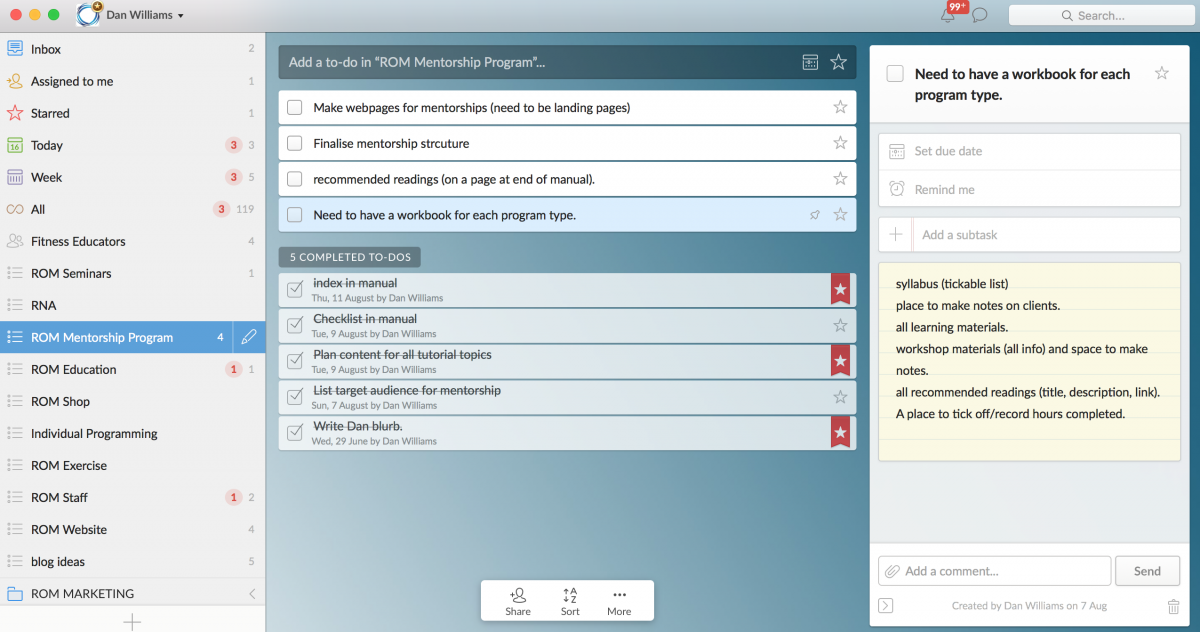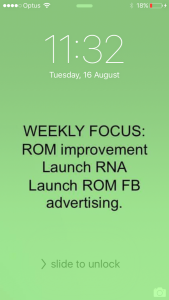This system is something that I’ve developed from spending a lot of time:
- Researching productivity and choosing the bits I like.
- Examining my own behaviour and psychology to develop something that works for me.
Yearly Systemisation: Value Identification:
I realise that anything I do has to align to my values. If I don’t value something, I can’t trust that my future self will place enough importance on it to get it done. And honestly, if I don’t value it, there’s no benefit in getting it done anyway.So I spend a considerable amount of time at the end of each year narrowing down my values. This is my belief system that runs a common thread through everything I do.
I develop an overriding primary value, which this year, is happiness. That is the purpose of everything I do. If anything else undermines that, then that thing doesn’t belong. Beneath this primary value I have three Personal Values, and three Professional Values.
This year, my Personal Values are:
- Reciprocal Altruism through empathy (something I’ve tried to adapt from ‘The Golden Rule’, because I don’t think anything is truly selfless).
- Health.
- Relationships.
And my Professional Values are:
- Leadership.
- Achievement.
- Wealth.
I define each of these for my own clarification.
When things get busy and complicated in life, I can zoom out. At the limits of this zoom, these values are the things that matter, and I can fall back on them to drive how I think, feel and act.
My values sit atop a laminated A3 sheet of paper on the outside of my shower screen. Beneath these values are my outcome based goals.
Yearly Systemisation: Outcome Goals:
Once I’ve established my values, I can develop a set of goals that work to support these values. I complete this at the end of each year.
I begin with outcome based goals. These are useful for identifying my destination. They do little to provide directions to arrive at this destination, but at least I know where I want to be heading. They keep me focused. These outcome goals all meet the criteria of being specific, measureable, realistic, action-based and time orientated.
In 2016 I have 35 outcome based goals. This may seem like a lot, but it works for me. These 35 outcome goals are divided into 10 categories, which this year include:
- Relationship goals.
- Overall finance.
- Performance Tracking (how I keep track of my own performance).
- Educating others.
- Personal development (self).
My outcome goals sit below my values on the outside of my shower screen. I get a reminder at the start of each month to re-read these outcome goals, and I’m also exposed to them every time I have a shower.
Yearly Systemisation: Process Goals:
Once I’ve established what I want to achieve for the year (my process goals), the next step is to determine how I’m going to get there. These are my process goals – the actions I can take to reach the desired destination.
For each outcome based goals, there are many process goals. The more I have, the clearer the steps I need to take. The closer together these steps, the easier each one is. I work backwards chronologically with these, starting with the outcome goal, and determining how to get there.
My process goals are basically my ‘to do list’ for the year and are stored in the ‘list making’ app I choose to use, ‘Wunderlist’. Wunderlist allows me to categorise my process goals into lists/folders, with each list/folder being one of my outcome goals. Using this app, I can tick off process goals as I complete them, and can set both reminders and ‘due dates’ to ensure I remain on track with my steps to reach my outcome goal. I can also assign sub-tasks and notes to each process goal. You can see below this system in action for a Mentorship Program I’m working towards launching. I currently have 13 primary folders of process goals in use, with three of these containing sub-folders.

Weekly Systemisation:
Every Sunday I spend about 10 minutes organising my thoughts and tasks for the week. If I just let my mind go, it tends to get easily distracted by new ideas and concepts, so this 10 minute block is my way of keeping focus. I identify three main categories that I want to focus on during the week. Yes, other day-to-day tasks will come and go, but the three focuses ensure I always return from ‘working in’ to ‘working on’. I set these three focuses on the lock screen of my phone on a lime green background so they’re always visible. The sub tasks for these focuses are already in Wunderlist. If I need to add to the list, I do.

Daily Systemisation:
Every morning, before I get to work any any of my tasks, I identify the three things that I want to accomplish for the day. My mood and happiness seems to be very dependent on my ability to create and accomplish, so this draws my attention to these achievements. The complexity and magnitude of these tasks is dependent on how much time I can afford to allocate to ‘work on’ (not in) for that day. Again, these daily focuses keep my mind on task and return me to the important things if I lose focus. Quite often, the daily tasks will be things that have come up in the short term that may not necessarily be part of my long term yearly planning. Yet they still align with my goals and are therefore still important.
To keep my daily focuses, I use the application ‘Stickies’ which is stock on my Macbook Pro. It allows me to write a ‘sticky note’ and keep it on my desktop (where it’s always set as the front window). This ‘sticky’ is set to the same lime green as the lock screen on my phone. I also list my weekly focuses on this ‘sticky’ as an extra point of contact.

Hourly Systemisation:
I’ve found a lot of success using the ‘Pomodoro Technique’. This ‘interval working’ allows me to get an enormous amount of work done in a very short amount of time. Follow the link for more info, but basically I’ll:
- Work out how long one of my tasks (within Wunderlist) will take.
- Convert that to the number of 25 minute blocks it will take.
- Work with 100% focus on the task for 25 minutes.
- Rest for five minutes.
- Repeat until the task is compelte (but no longer than four 25 minute blocks).
This hourly systemisation is the absolute ‘micro’ of my productivity system.
Adherence:
This system works exceptionally well for me. In the past few years, I’ve noticed that my mood and motivation levels oscillate day to day, week to week, month to month. I used to get stressed when the mood and motivation dropped, and felt guilty that I was straying from the path I wanted to walk. Over the last 12 months though I’ve realised that these oscilations are part of the process. I understand that these ‘waves’ are a natural part getting to the destination. Once I realised this the troughs didn’t stress me as much, and I gave myself permission to be unproductive, underachieving and non-creative, knowing that the trough was temporary and the natural pattern of the wave would soon carry me back to where I wanted to be. So I don’t follow this productivity system all the time, but I do most of the time. And that’s fine with me.
This productivity system is what I have created and evolved to work best for me. It might not be best for you. Take the elements that resonate and combine them with your own knowledge of self to create your own personal productivity system.




